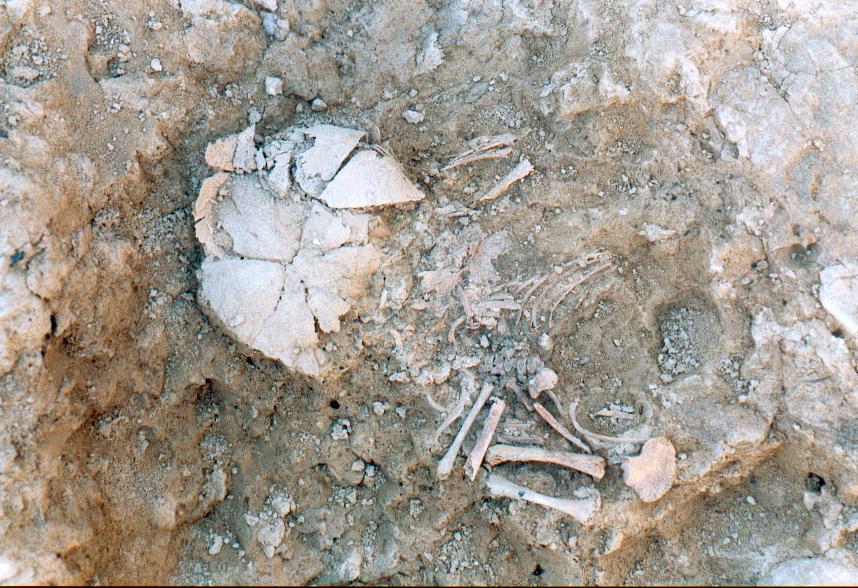Reactions to study finding remains of foetuses and babies with Down's and Edwards' syndromes thousands of years old
A team of researchers led by the Max Planck Institute for Evolutionary Anthropology in Germany has analysed nearly 10,000 ancient genomes and found six cases of people with Down's syndrome and one with Edwards' syndrome. Most of them died before or shortly after birth. The findings correspond to different periods up to 5,500 years old and several of them have been found in Navarra. According to the authors, "the care with which the burials were carried out and the objects found with these individuals indicate that ancient societies probably treated people with trisomies 18 and 21 as members of their communities". The findings are published in Nature Communications.

Inhumation of a foetus with Down's syndrome at the Iron Age site of Las Eretas (Navarra). It was buried inside one of the houses of the settlement. Credit: Government of Navarre and J.L. Larrion.
Antonio Salas Ellacuriaga - restos trisomías EN
Antonio Salas Ellacuriaga
Researcher in Population Genetics in Biomedicine at the Instituto de Investigación Sanitaria de Santiago de Compostela (IDIS) and Professor at the Faculty of Medicine of the University of Santiago de Compostela
From my perspective, the most remarkable innovation of this study lies not so much in the technical aspect (without detracting from the enormous computational effort and challenge), but in its conceptual approach. The idea of analysing a significant number of genomes from ancient remains, almost 10,000 in total, to investigate the prevalence of certain biomedical conditions in past societies is revealing. Furthermore, the integration of this information with anthropological and archaeological data provides a solid basis for hypothesising how these societies dealt with human diversity, especially in relation to well-known conditions such as Down syndrome and Edwards' syndrome.
The authors approach the study with outstanding technical skill and construct a cautious and self-critical account that reveals some limitations. Despite the presence of certain weaknesses, the study opens a significant window that will spark interest in further investigating other conditions and diseases with very low prevalences, which until now could not be addressed due to the limited population data available for ancient DNA.
Very briefly, the study argues that:
- The prevalence of trisomies does not appear to be significantly different from that observed in current populations. There is an insignificant deviation that could be due to sampling phenomena, preservation of skeletal remains, etc.
- Through the analysis of burial rituals, the authors suggest that ancient societies did not distinguish between individuals with these syndromes and other members of the population.
The most significant impact of this study lies in opening a new avenue of exploration of our past, highlighting the importance of integrating information from diverse fields of knowledge, from genetics to physical anthropology.
In my opinion, there are some weaknesses in the results of the study that are not sufficiently addressed. The question of prevalence is somewhat ambiguous. Although the overall prevalence of trisomy 21 (Down syndrome) is slightly lower than expected internationally (considering a correction for maternal age), it is striking that three of the six cases are concentrated in two nearby sites in Navarra (Spain) that correspond to the Early/Middle Iron Age (800 to 400 BC), generating an abnormally high (unreported) prevalence at the national level. The only detected case of Edwards syndrome is also recorded in this region. On the other hand, the presence of infant burials in the archaeological record is scarcer than adult burials, so the prevalence of these syndrome cases in the context of infant burials could be abnormally high in the data set studied, significantly altering the overall and national prevalence estimate.
I always consider it good practice to develop discussions not only with what one finds, but also with what one does not observe in the record. This comment is relevant because all the cases detected are perinatal (or neonatal; the use of neonatal/perinatal is ambiguous) and only one infant is identified. It is curious that older individuals, or simply more infants, do not appear, given that the average life expectancy of people with Down syndrome should favour their more frequent presence in the archaeological record. The absence of such cases in burials could lead us to rethink whether ancient societies treated diversity equitably, which would call into question one of the fundamental conclusions of the paper.
The most obvious limitation, from my perspective, lies in the need to interpret society's perception of people affected by syndromes based on how they were buried. The burial ritual could provide only a partial perspective on the story. In addition, since all identified cases correspond to early age stages (perinates/neonates/infants), there is a possibility that these individuals had not yet developed distinctive features. This could lead to a homogeneous treatment in the burial ritual due to the lack of identification of these traits.
In time, it will undoubtedly be possible to deepen these studies and validate the results of the research. For now, this initial proposal is extremely attractive, opening a new window into our past (where do we come from?), always crucial to become aware of ourselves (who are we?) and to understand the human condition in a future social context (where are we going?).
Iñigo Olalde - restos trisomías EN
Iñigo Olalde
Geneticist and Ikerbasque and Ramón y Cajal researcher at the University of the Basque Country (UPV/EHU)
It is a study that complies with all established protocols for the recovery of DNA from old samples and the minimisation of the risk of contamination with modern DNA. It is a study of excellent quality.
It is not the first time that Down's syndrome cases have been identified in ancient samples, but this work is the first large-scale search. They have analysed genomic data from 10,000 ancient individuals and, in addition, they describe a new statistical method for identifying cases of trisomies that is adapted to the special characteristics of ancient DNA, which is often highly degraded. Future studies of ancient DNA will most likely use this new method to search for trisomy cases.
On the technical side, I don't see any major limitations. Perhaps in the interpretation, when they state that these individuals with trisomies were identified as full members of these communities, it should be said that it is possible that they were not aware that these individuals (all newborns) had any pathology and that is why they were given the standard burial ritual. In the case of Down's syndrome, for example, at the moment of birth, traits that we now know are associated with Down's syndrome can be seen, but it is possible that ancient societies were not aware of this association. This limitation is mentioned in the article.
Rosa Fregel - restos trisomía EN
Rosa Fregel Lorenzo
Associate Professor
Head of the Evolution, population genetics and paleogenomics research group
This study led by Rohrlach demonstrates the great potential of paleogenomic techniques to study the past. In this case, the team used genomic data to identify individuals from the past who had any of the three trisomies that are not fatal in humans: Down syndrome (chromosome 21 trisomy), Edwards syndrome (chromosome 18) and Patau syndrome (chromosome 13). From a database of almost 10,000 individuals, they determined that six infants had Down syndrome and only one had Edwards syndrome. Although previous studies, such as the one published by Cassidy in 2020 and more recently in 2024 by Anastasiadou, had already identified older individuals with Down's syndrome, this is the first time the presence of Edwards' syndrome has been discovered. Perhaps most interestingly, three of the six cases of Down's syndrome and the one case of Edwards' syndrome have been detected in Iron Age sites in Navarra, in intramural burials of newborns. Given that the funerary practices of this population included the cremation of human remains, it is interesting that these children were buried differently and with great care in all cases.
I believe that the study is based on robust data and analysis, and that its conclusions are supported by its results. I do not think there are any limitations to be considered.
Rohrlach et al.
- Research article
- Peer reviewed



